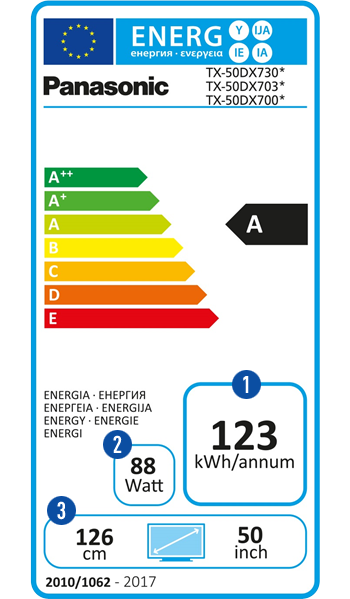The EU Energy Label Explained

Lots of products you can buy now show an energy label, but it isn't just energy information that they contain. This means that the label is different for each type of product.
It's also worth remembering that there may be reasons why some products use a bit more energy than others. For example a TV that has advanced features like 4k (Ultra High Definition) is likely to use a little more energy than a Standard Definition TV. Where the energy label is useful is in comparing different products with the same function and features.
So let's look at a typical label first and then you can learn more about the label for each product type further down the page.
EU Energy Label Overview
1. Energy Ranking
Products are ranked on their energy efficiency on a scale from A+++ to D.
A+++ being the most efficient.
Each level on this scale is not an exact value but in fact an upper and lower limit for energy efficiency that the product must fall within to be categorised in that band.
As such two products that have the same rating may not be of equal efficiency.
It is therefore important to also look at the energy consumption of the product.*
2. Energy Rating
Energy efficiency rating of specific product.
3. Annual Energy Consumption
*Annual energy consumption of the product in KWh (based on "average usage").
A KWh is a unit of energy and costs about 14p (based on government figures from 2015).
“Average usage” may not reflect actual usage so should be used as a guide to predicting energy use.
The main use of this figure is as a more accurate way to compare the energy consumption of similar products that have the same energy rating.
4. Category Specific Information
The boxes in the lower section of the energy label provide category specific information.
5. Product Code

Television
1. Average energy consumption of the product in kilowatt hours (kWh) for a year.
2. The power consumption of the TV in Watts.
3. Diagonal length of visible screen, in centimetres and inches.


Fridge Freezer
1. Average energy consumption of the product in kilowatt hours (kWh) for a year.
2. Storage volume of fridge.
3. Storage volume freezer.
4. Operational noise emission, in decibels.


Washing Machine
1. Average energy consumption of the product in kilowatt hours (kWh) for a year.
2. Average annual water consumption, in Litres.
3. Weight of the maximum load that the washing machine can handle, in Kilograms.
4. Spin drying efficiency rating.: ‘A’ being the most efficient.
5. Noise emitted during wash cycle, in decibels.
6. Noise emitted during spin cycle, in decibels.
Note: 4&5. Noise or sound is measured in decibels. The sound of normal conversation in a public place is about 60 decibels. 50 decibels, although only being 10 decibels lower, sounds half as loud. Similarly, 70 decibels sounds twice as loud as 60 decibels and 4 times as loud as 50 decibels.

Tumble Drier
1. Average energy consumption of the product in kilowatt hours (kWh) for a year.
2. Type of Tumble Dryer (in this case condensing).
3. Programme time with full load.
4. Load capacity.
5. Noise emissions, in Decibels.
6. Condensing Efficiency class.

